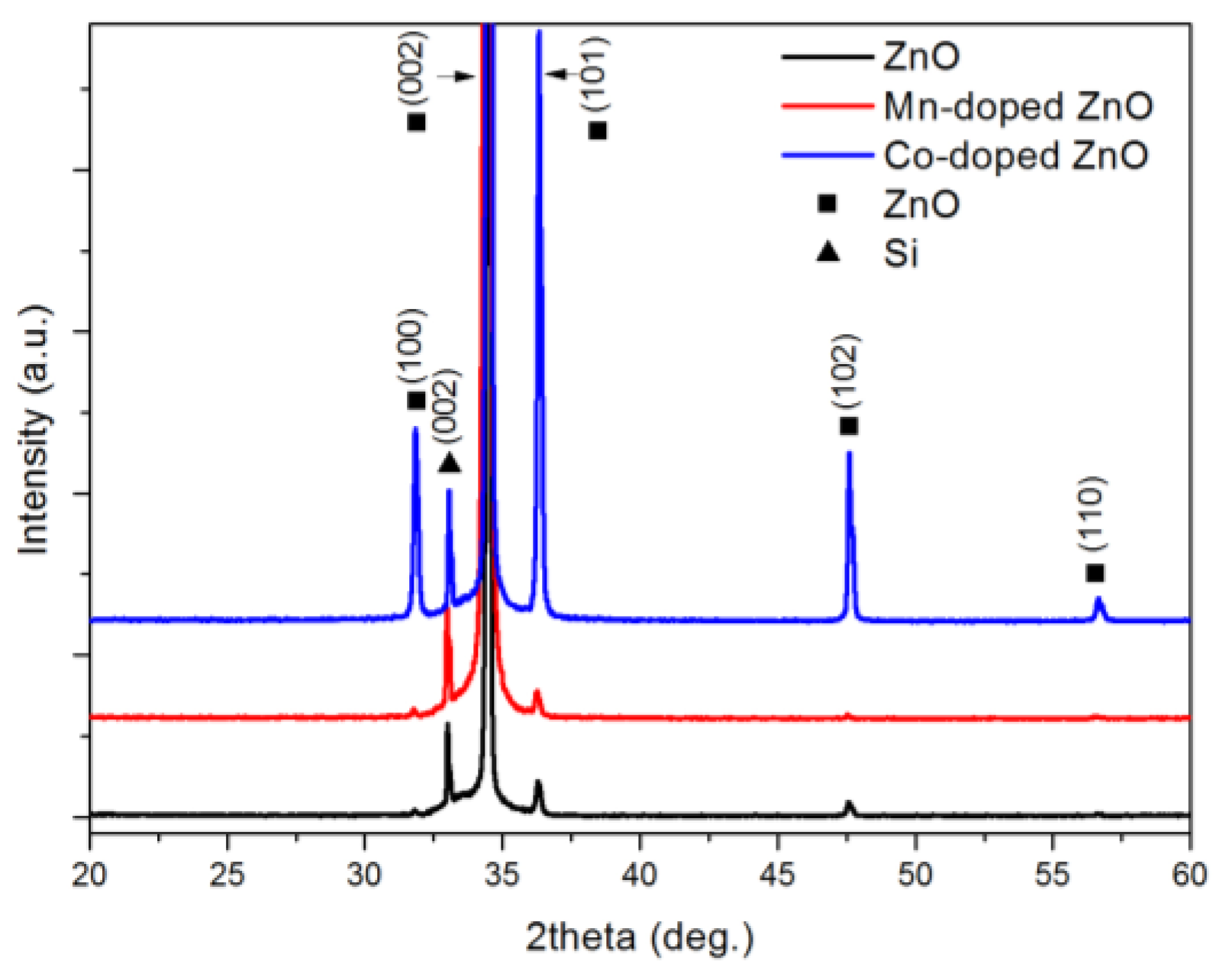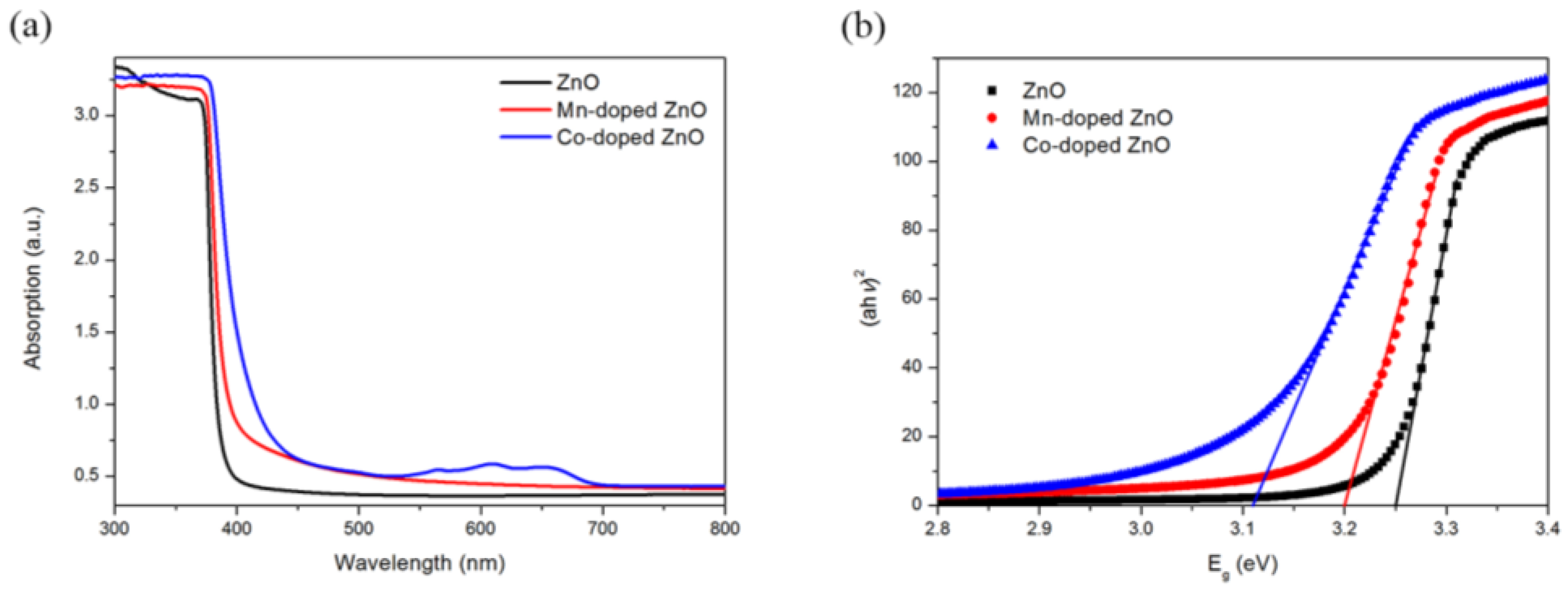Enhanced Visible Light Photocatalytic Activity of ZnO Nanowires Doped with Mn2+ and Co2+ Ions
Abstract
:1. Introduction
2. Materials and Methods
2.1. Materials
2.2. Preparation Ion of ZnO Seed Layer
2.3. Synthesis of Mn2+- and Co2+-Doped ZnO Nanowires
2.4. Characterization
2.5. Photocatalytic Performance
3. Results and Discussion
3.1. Characterization
3.2. Methyl Orange Photocatalytic Degradation
4. Conclusions
Acknowledgments
Author Contributions
Conflicts of Interest
References
- Fujishima, A.; Honda, K. Electrochemical photolysis of water at a semiconductor electrode. Nature 1972, 238, 37–38. [Google Scholar] [CrossRef] [PubMed]
- Li, Z.C.; Xiong, S.; Wang, G.J.; Xie, Z.; Zhang, Z.J. Role of Ag2S coupling on enhancing the visible-light-induced catalytic property of TiO2 nanorod arrays. Sci. Rep. 2016, 6, 19754. [Google Scholar] [CrossRef] [PubMed]
- Li, Z.C.; Teng, Y.; Chen, C.H.; Lv, S.S.; Wang, G.J.; Zhang, Z.J. Effect of Xe ion irradiation on photocatalytic performance of oblique TiO2 nanowire arrays. Appl. Surf. Sci. 2015, 327, 478–482. [Google Scholar] [CrossRef]
- Chen, C.H.; Li, Z.C.; Lin, H.N.; Wang, G.J.; Liao, J.C.; Li, M.Y.; Lv, S.S.; Li, W. Enhanced visible light photocatalytic performance of ZnO nanowires integrated with CdS and Ag2S. Dalton Trans. 2016, 45, 3750–3758. [Google Scholar] [CrossRef] [PubMed]
- Yan, S.C.; Li, Z.S.; Zou, Z.G. Photodegradation of Rhodamine B and Methyl Orange over Boron-Doped g-C3N4 under Visible Light Irradiation. Langmuir 2010, 26, 3894–3901. [Google Scholar] [CrossRef] [PubMed]
- Li, Q.; Guo, B.D.; Yu, J.G.; Ran, J.R.; Zhang, B.H.; Yan, H.J.; Gong, J.R. Highly Efficient Visible-Light-Driven Photocatalytic Hydrogen Production of CdS-Cluster-Decorated Graphene Nanosheets. J. Am. Chem. Soc. 2011, 133, 10878–10884. [Google Scholar] [CrossRef] [PubMed]
- Özgür, Ü.; Alivov, Y.I.; Liu, C.; Teke, A.; Reshchikov, M.A.; Doğan, S.; Avrutin, V.; Cho, S.-J.; Morko, H. A comprehensive review of ZnO materials and devices. J. Appl. Phys. 2005, 98, 041301. [Google Scholar] [CrossRef]
- Liao, J.C.; Li, Z.C.; Wang, G.J.; Chen, C.H.; Lv, S.S.; Li, M.Y. ZnO nanorod/porous silicon nanowire hybrid structures as highly-sensitive NO2 gas sensors at room temperature. Phys. Chem. Chem. Phys. 2016, 18, 4835–4841. [Google Scholar] [CrossRef] [PubMed]
- Zhang, Q.F.; Dandeneau, C.S.; Zhou, X.Y.; Cao, G.Z. ZnO Nanostructures for Dye-Sensitized Solar Cells. Adv. Mater. 2009, 21, 4087–4108. [Google Scholar] [CrossRef]
- Steinfeld, A. Solar hydrogen production via a two-step water-splitting thermochemical cycle based on Zn-ZnO redox reactions. Int. J. Hydrog. Energy 2002, 27, 611–619. [Google Scholar] [CrossRef]
- Wang, G.J.; Li, Z.C.; Li, M.Y.; Liao, J.C.; Chen, C.H.; Lv, S.S.; Shi, C.Q. Enhanced field-emission of silver nanoparticle-graphene oxide decorated ZnO nanowire arrays. Phys. Chem. Chem. Phys. 2015, 17, 31822–31829. [Google Scholar] [CrossRef] [PubMed]
- Johnson, J.C.; Yan, H.Q.; Schaller, R.D.; Haber, L.H.; Saykally, R.J.; Yang, P.D. Single Nanowire Lasers. J. Phys. Chem. B 2001, 105, 11388–11390. [Google Scholar] [CrossRef]
- Tsukazaki, A.; Ohtomo, A.; Onuma, T.; Ohtani, M.; Makino, T.; Sumiya, M.; Ohtani, K.; Chichibu, S.; Fuke, S.; Segawa, Y.; et al. Repeated temperature modulation epitaxy for p-type doping and light-emitting diode based on ZnO. Nat. Mater. 2005, 4, 42–46. [Google Scholar] [CrossRef]
- Saleh, R.; Djaja, N.F. UV light photocatalytic degradation of organic dyes with Fe-doped ZnO nanoparticles. Superlattices Microstruct. 2014, 74, 217–233. [Google Scholar] [CrossRef]
- Zhao, J.; Wang, L.; Yan, X.Q.; Yang, Y.; Lei, Y.; Zhou, J.; Huang, Y.H.; Gu, Y.S.; Zhang, Y. Structure and photocatalytic activity of Ni-doped ZnO nanorods. Mater. Res. Bull. 2011, 46, 1207–1210. [Google Scholar] [CrossRef]
- Mohan, R.; Krishnamoorthy, K.; Kim, S.J. Enhanced photocatalytic activity of Cu-doped ZnO nanorods. Solid State Commun. 2012, 152, 375–380. [Google Scholar] [CrossRef]
- Wu, C.L.; Shen, L.; Zhang, Y.C.; Huang, Q.L. Solvothermal synthesis of Cr-doped ZnO nanowires with visible light-driven photocatalytic activity. Mater. Lett. 2011, 65, 1794–1796. [Google Scholar] [CrossRef]
- Etacheri, V.; Roshan, R.; Kumar, V. Mg-Doped ZnO Nanoparticles for Efficient Sunlight-Driven Photocatalysis. Appl. Mater. Interfaces 2012, 4, 2717–2725. [Google Scholar] [CrossRef] [PubMed]
- Koidl, P. Optical absorption of Co2+ in ZnO. Phys. Rev. B 1977, 15, 2493–2499. [Google Scholar] [CrossRef]
- Mahmood, M.A.; Baruah, S.; Dutta, J. Enhanced visible light photocatalysis by manganese doping or rapid crystallization with ZnO nanoparticles. Mater. Chem. Phys. 2011, 130, 531–535. [Google Scholar] [CrossRef]
- He, R.L.; Hocking, R.K.; Tsuzuki, T. Co-doped ZnO nanopowders Location of cobalt and reduction in photocatalytic activity. Mater. Chem. Phys. 2012, 132, 1035–1040. [Google Scholar] [CrossRef]
- Ma, Q.; Lv, X.Z.; Wang, Y.Q.; Chen, J.Y. Optical and photocatalytic properties of Mn doped flower-like ZnO hierarchical structures. Opt. Mater. 2016, 60, 86–93. [Google Scholar] [CrossRef]
- Kuriakose, S.; Satpatib, B.; Mohapatra, S. Enhanced photocatalytic activity of Co doped ZnO nanodisks and nanorods prepared by a facile wet chemical method. Phys. Chem. Chem. Phys. 2014, 16, 12741–12749. [Google Scholar] [CrossRef] [PubMed]
- Li, X.; Li, J.H.; Li, S.J.; Fang, X.; Fang, F.; Chu, X.Y.; Wang, X.H.; Hu, J.X. Fabrication and Visible Light Photocatalytic Activity of Co-doped ZnO Nanorods. Chem. Res. Chin. Univ. 2013, 29, 1032–1035. [Google Scholar] [CrossRef]
- Jang, J.S.; Kim, E.S.; Choi, S.H.; Kim, D.H.; Kim, H.G.; Lee, J.S. Synthesis, electronic property and photocatalytic applications of mesoporous cobalt-doped ZnS and ZnO nanoplates. Appl. Catal. A 2012, 427–428, 106–113. [Google Scholar] [CrossRef]
- Xu, L.P.; Hu, Y.L.; Pelligra, C.; Chen, C.H.; Jin, L.; Huang, H.; Sithambaram, S.; Aindow, M.; Joesten, R.; Suib, S.L. ZnO with Different Morphologies Synthesized by Solvothermal Methods for Enhanced Photocatalytic Activity. Chem. Mater. 2009, 21, 2875–2885. [Google Scholar] [CrossRef]
- Mclaren, A.; Solis, T.V.; Li, G.Q.; Tsang, S.C. Shape and Size Effects of ZnO Nanocrystals on Photocatalytic Activity. J. Am. Chem. Soc. 2009, 131, 12540–12541. [Google Scholar] [CrossRef] [PubMed]
- Li, D.; Haneda, H. Morphologies of zinc oxide particles and their effects on photocatalysis. Chemosphere 2003, 51, 129–137. [Google Scholar] [CrossRef]
- Parnis, J.M.; Oldham, K.B. Beyond the Beer–Lambert law: The dependence of absorbance on time in photochemistry. J. Photochem. Photobiol. A 2013, 267, 6–10. [Google Scholar] [CrossRef]
- Wagner, C.D.; Riggs, W.M.; Davis, L.E.; Moulder, J.F.; Muilenberg, G.E. Handbook of X-ray Photoelectron Spectroscopy; PerkinElme: Eden Prairie, MN, USA, 1979; pp. 88–89. [Google Scholar]
- Yang, L.L.; Zhao, Q.X.; Willander, M.; Liu, X.J.; Fahlman, M.; Yang, J.H. Origin of the surface recombination centers in ZnO nanorods arrays by X-ray photoelectron spectroscopy. Appl. Surf. Sci. 2010, 256, 3592–3597. [Google Scholar] [CrossRef]
- Prabhakar, R.R.; Mathews, N.; Jinesh, K.B.; Karthik, K.R.G.; Praman, S.S.; Varghese, B.; Sow, C.H.; Mhaisalkar, S. Efficient multispectral photodetection using Mn doped ZnO nanowires. J. Mater. Chem. 2012, 22, 9678. [Google Scholar] [CrossRef]
- Serpone, N.; Lawless, D.; Khairutdinov, R. Size effects on the photophysical properties of colloidal anatase TiO2 particles: Size quantization versus direct transitions in this indirect semiconductor? J. Phys. Chem. 1995, 99, 16646–16654. [Google Scholar] [CrossRef]
- Yang, P.; Yan, H.; Mao, S.; Russo, R.; Johnson, J.; Saykally, R.; Morris, N.; Pham, J.; He, R.; Choi, H.-J. Controlled growth of ZnO nanowires and their optical properties. Adv. Funct. Mater. 2002, 12, 323. [Google Scholar] [CrossRef]
- Prabhakar, R.R.; Pramana, S.S.; Karthik, K.R.G.; Sow, C.H.; Jinesh, K.B. Efficient multispectral photodetection using Mn doped ZnO nanowires. J. Mater. Chem. 2012, 22, 13965. [Google Scholar] [CrossRef]
- Zeng, H.B.; Liu, P.S.; Cai, W.P.; Yang, S.K.; Xu, X.X. Controllable Pt/ZnO Porous Nanocages with Improved Photocatalytic Activity. J. Phys. Chem. C 2008, 112, 19620–19624. [Google Scholar] [CrossRef]







| Element | Atomic Percentage (%) | |
|---|---|---|
| Mn-Doped ZnO | Co-Doped ZnO | |
| C | 9.31 | 13.50 |
| Zn | 43.23 | 40.97 |
| O | 44.73 | 44.84 |
| Mn | 2.72 | / |
| Co | / | 0.69 |
| Sample | The First-Order Rate Constants (min−1) |
|---|---|
| ZnO | 0.00265 |
| Mn-doped ZnO | 0.00436 |
| Co-doped ZnO | 0.00520 |
© 2017 by the authors; licensee MDPI, Basel, Switzerland. This article is an open access article distributed under the terms and conditions of the Creative Commons Attribution (CC-BY) license (http://creativecommons.org/licenses/by/4.0/).
Share and Cite
Li, W.; Wang, G.; Chen, C.; Liao, J.; Li, Z. Enhanced Visible Light Photocatalytic Activity of ZnO Nanowires Doped with Mn2+ and Co2+ Ions. Nanomaterials 2017, 7, 20. https://doi.org/10.3390/nano7010020
Li W, Wang G, Chen C, Liao J, Li Z. Enhanced Visible Light Photocatalytic Activity of ZnO Nanowires Doped with Mn2+ and Co2+ Ions. Nanomaterials. 2017; 7(1):20. https://doi.org/10.3390/nano7010020
Chicago/Turabian StyleLi, Wei, Guojing Wang, Chienhua Chen, Jiecui Liao, and Zhengcao Li. 2017. "Enhanced Visible Light Photocatalytic Activity of ZnO Nanowires Doped with Mn2+ and Co2+ Ions" Nanomaterials 7, no. 1: 20. https://doi.org/10.3390/nano7010020






